最新PEP人教版小学英语六年级下册自然拼读法1
- 格式:doc
- 大小:36.00 KB
- 文档页数:4
![六年级下册英语自然拼读教程课件- [i][ i]发音技巧与训练 全国通用](https://uimg.taocdn.com/c94a2e19d0d233d4b04e6975.webp)
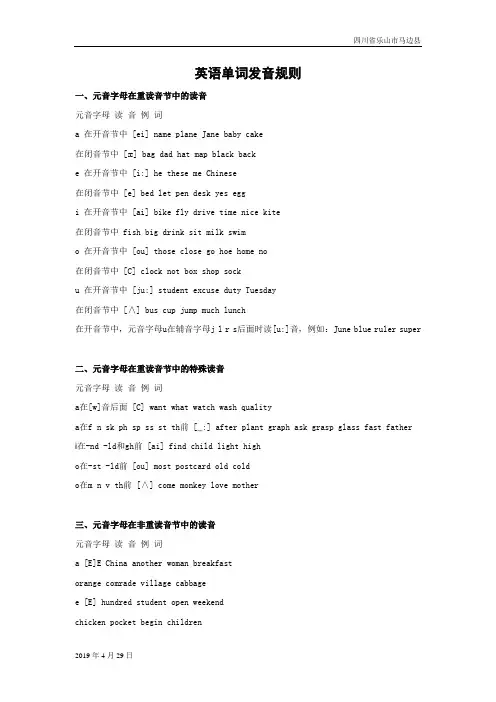
英语单词发音规则一、元音字母在重读音节中的读音元音字母读音例词a 在开音节中 [ei] name plane Jane baby cake在闭音节中 [æ] bag dad hat map black backe 在开音节中 [i:] he these me Chinese在闭音节中 [e] bed let pen desk yes eggi 在开音节中 [ai] bike fly drive time nice kite在闭音节中 fish big drink sit milk swimo 在开音节中 [ou] those close go hoe home no在闭音节中 [C] clock not box shop socku 在开音节中 [ju:] student excuse duty Tuesday在闭音节中 [∧] bus cup jump much lunch在开音节中,元音字母u在辅音字母j l r s后面时读[u:]音,例如:June blue ruler super二、元音字母在重读音节中的特殊读音元音字母读音例词a在[w]音后面 [C] want what watch wash qualitya在f n sk ph sp ss st th前 [_:] after plant graph ask grasp glass fast father i在-nd -ld和gh前 [ai] find child light higho在-st -ld前 [ou] most postcard old coldo在m n v th前 [∧] come monkey love mother三、元音字母在非重读音节中的读音元音字母读音例词a [E]E China another woman breakfastorange comrade village cabbagee [E] hundred student open weekendchicken pocket begin childreni [E]/ holiday beautiful family animal[ai] exercise satelliteo [E] second tonight somebody welcome[Eu] also zero photou [E] autumn difficult[ju:] popular congratulation January动词中的a如果处在开音节位置,a读[ei]音,例如:operateu处在开音节位置,又在辅音字母j l r s后面时,读[u(:)]音,例如:July influence February issue在非重读音节中,许多单词中的元音字母a e i 即可以读作[E]音,也可以读作音。
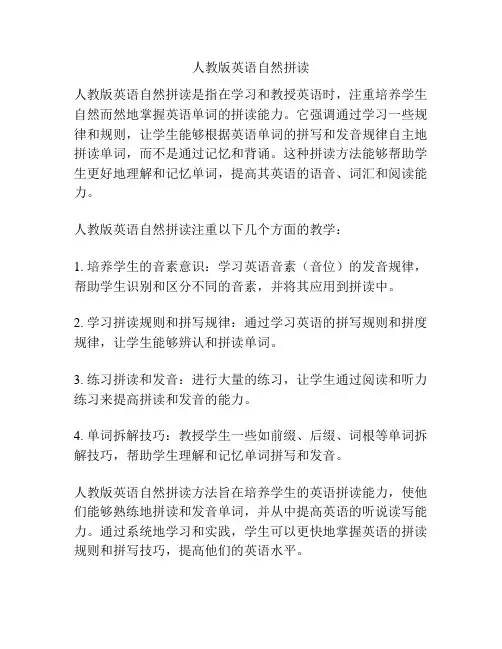
人教版英语自然拼读
人教版英语自然拼读是指在学习和教授英语时,注重培养学生自然而然地掌握英语单词的拼读能力。
它强调通过学习一些规律和规则,让学生能够根据英语单词的拼写和发音规律自主地拼读单词,而不是通过记忆和背诵。
这种拼读方法能够帮助学生更好地理解和记忆单词,提高其英语的语音、词汇和阅读能力。
人教版英语自然拼读注重以下几个方面的教学:
1. 培养学生的音素意识:学习英语音素(音位)的发音规律,帮助学生识别和区分不同的音素,并将其应用到拼读中。
2. 学习拼读规则和拼写规律:通过学习英语的拼写规则和拼度规律,让学生能够辨认和拼读单词。
3. 练习拼读和发音:进行大量的练习,让学生通过阅读和听力练习来提高拼读和发音的能力。
4. 单词拆解技巧:教授学生一些如前缀、后缀、词根等单词拆解技巧,帮助学生理解和记忆单词拼写和发音。
人教版英语自然拼读方法旨在培养学生的英语拼读能力,使他们能够熟练地拼读和发音单词,并从中提高英语的听说读写能力。
通过系统地学习和实践,学生可以更快地掌握英语的拼读规则和拼写技巧,提高他们的英语水平。
![六年级下册英语自然拼读教程课件 [θ][e]发音技巧与训练 全国通用PPT](https://uimg.taocdn.com/2bd80f2484868762cbaed548.webp)
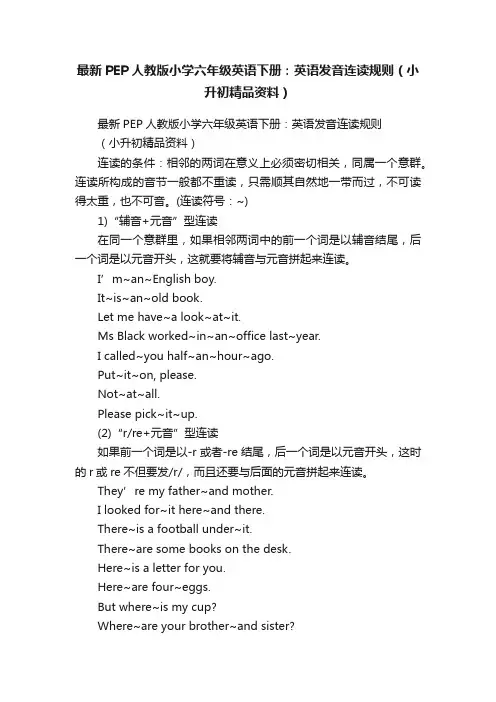
最新PEP人教版小学六年级英语下册:英语发音连读规则(小
升初精品资料)
最新PEP人教版小学六年级英语下册:英语发音连读规则
(小升初精品资料)
连读的条件:相邻的两词在意义上必须密切相关,同属一个意群。
连读所构成的音节一般都不重读,只需顺其自然地一带而过,不可读得太重,也不可音。
(连读符号:~)
1)“辅音+元音”型连读
在同一个意群里,如果相邻两词中的前一个词是以辅音结尾,后一个词是以元音开头,这就要将辅音与元音拼起来连读。
I’m~an~English boy.
It~is~an~old book.
Let me have~a look~at~it.
Ms Black worked~in~an~office last~year.
I called~you half~an~hour~ago.
Put~it~on, please.
Not~at~all.
Please pick~it~up.
(2)“r/re+元音”型连读
如果前一个词是以-r或者-re结尾,后一个词是以元音开头,这时的r或re不但要发/r/,而且还要与后面的元音拼起来连读。
They’re my father~and mother.
I looked for~it here~and there.
There~is a football under~it.
There~are some books on the desk.
Here~is a letter for you.
Here~are four~eggs.
But where~is my cup?
Where~are your brother~and sister?。
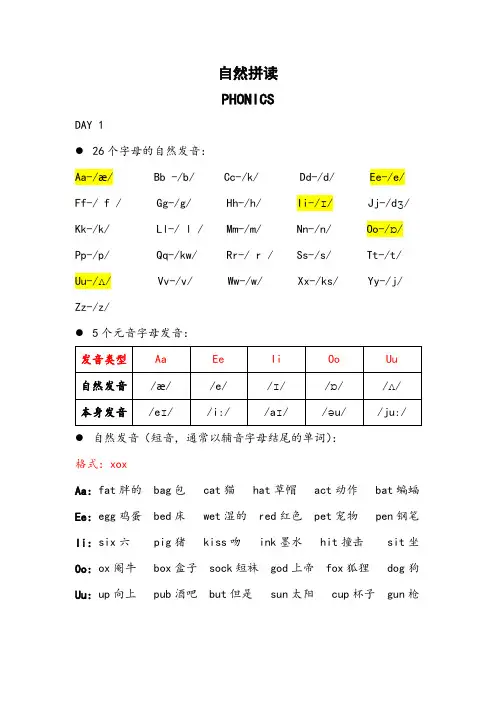
自然拼读PHONICSDAY 1●26个字母的自然发音:Aa-/æ/ Bb -/b/ Cc-/k/ Dd-/d/ Ee-/e/Ff-/ f / Gg-/g/ Hh-/h/ Ii-/ɪ/ Jj-/dʒ/ Kk-/k/ Ll-/ l / Mm-/m/ Nn-/n/ Oo-/ɒ/Pp-/p/ Qq-/kw/ Rr-/ r / Ss-/s/ Tt-/t/ Uu-/ʌ/ Vv-/v/ Ww-/w/ Xx-/ks/ Yy-/j/ Zz-/z/●5个元音字母发音:●自然发音(短音,通常以辅音字母结尾的单词):格式:xoxAa: fat胖的 bag包 cat猫 hat草帽 act动作 bat蝙蝠Ee: egg鸡蛋 bed床 wet湿的 red红色 pet宠物 pen钢笔Ii: six六 pig猪 kiss吻 ink墨水 hit撞击 sit坐Oo: ox阉牛 box盒子 sock短袜 god上帝 fox狐狸 dog狗Uu: up向上 pub酒吧 but但是 sun太阳 cup杯子 gun枪Tips:1.拼读:辅音+元音:ca=/k/+/æ/2.拼读:元音+辅音at=/æ/+/t/;3. 拼读:辅音+元音+辅音:cat=/k/+/æ/+/t/4. 如果单词或音节里只有一个元音,且元音不在末尾,这个元音一般发短音5. 在以后的学习中,我们用X表示辅音,O表示元音。
Exercise1.阅读。
我家dad,脾气bad,让我sad。
有只cat,非常fat,专吃rat。
撇下net,鱼没get,衣服wet。
一只pig,非常big,把洞dig。
没给tip,把我lip,装上zip。
2.给下列单词排序。
cut wet hug bag sit ( ) ( ) ( ) ( ) ( )DAY 2●5个元音字母发音:●本身发音(通常以不发音的元音“e”结尾的单词,silent“e”)格式:xoxe(相对开音节)x a x e: take拿 wake睡醒 cake蛋糕 game游戏 date日期x e x e: dene沙丘 Lene(琳恩,人名)x i x e: dive潜水 bite咬 five五 side边;面 ride骑x o x e: hope希望 rose玫瑰 rope绳子 pose姿势 code密码x u x e: cube立方体 June六月 cute可爱 mute哑巴 dupe上当者格式:XO(绝对开音节)no不是 hi嗨 me我(宾格) he他 we我们●Tips:1开音节分为相对开音节(xoxe)和绝对开音节(xo);2.口诀:比如take拼读:xxooxxe,元音元音发本音,元音A,AAA,TTTttt,t ei tei,KKKkkk,take,尾e尾e不发音。
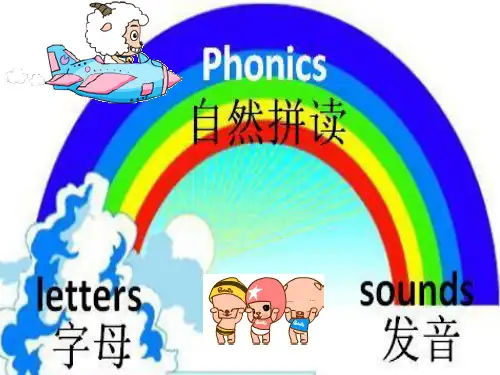
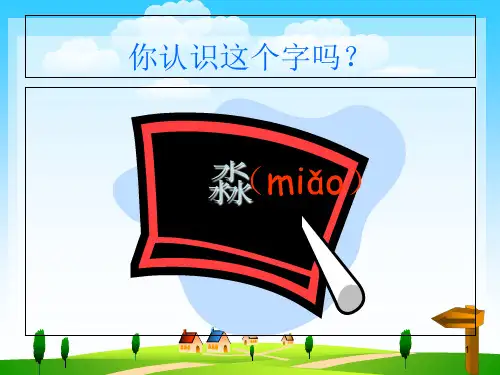
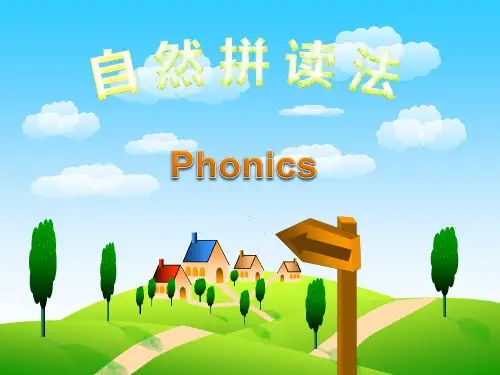
![六年级下英语自然拼读教程课件- 双唇爆破辅音[p][b]发音技巧与训练 全国通用](https://uimg.taocdn.com/1f8a7f6a6137ee06eef91834.webp)
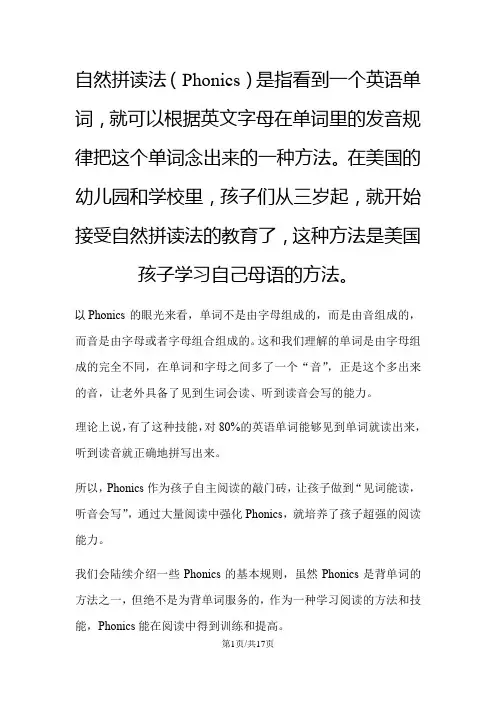
自然拼读法(Phonics)是指看到一个英语单词,就可以根据英文字母在单词里的发音规律把这个单词念出来的一种方法。
在美国的幼儿园和学校里,孩子们从三岁起,就开始接受自然拼读法的教育了,这种方法是美国孩子学习自己母语的方法。
以Phonics的眼光来看,单词不是由字母组成的,而是由音组成的,而音是由字母或者字母组合组成的。
这和我们理解的单词是由字母组成的完全不同,在单词和字母之间多了一个“音”,正是这个多出来的音,让老外具备了见到生词会读、听到读音会写的能力。
理论上说,有了这种技能,对80%的英语单词能够见到单词就读出来,听到读音就正确地拼写出来。
所以,Phonics作为孩子自主阅读的敲门砖,让孩子做到“见词能读,听音会写”,通过大量阅读中强化Phonics,就培养了孩子超强的阅读能力。
我们会陆续介绍一些Phonics的基本规则,虽然Phonics是背单词的方法之一,但绝不是为背单词服务的,作为一种学习阅读的方法和技能,Phonics能在阅读中得到训练和提高。
所以说Phonics并非万能,它只是阅读的起点,如果把Phonics作为最终目标就错了!自然拼读系列之一英文的26个字母,分为元音和辅音,其中元音只有5个,即a,e,i,o,u,其余字母均为辅音。
对于大多数辅音来说,它们的发音是一对一的,而有少数几个辅音字母,每个字母有两个或以上的发音。
字母与发音一一对应的辅音:b -- balld -- dogf -- fishh -- hatj -- jumpk -- kitel -- legm -- mann -- notp -- penq -- quick (注意q与u总是连在一起的)r -- runs -- sunt -- tenv -- vestw -- waterz – zoo有多个发音的辅音:c字母:c后面接a,o,u的时候,c的发音与字母k发音相同,叫做“hard c sound”cat, cap,call,coat,cup;当字母c后面接e,i,或y的时候,通常c的发音与字母s发音相同,叫做“soft c sound”city, ice, rice, face, cell, cent, voice, pencil, juice;有时在e或i前面,c会发/sh/音ocean, racial, social。
小学英语自然拼读课件1一、教学内容1. 学习26个字母的发音规则。
2. 掌握常见字母组合的发音。
3. 学会在单词中运用自然拼读法进行拼读。
二、教学目标1. 学生能够熟练掌握26个字母的发音规则。
2. 学生能够识别和拼读常见字母组合。
3. 学生能够在实际阅读中运用自然拼读法,提高阅读能力。
三、教学难点与重点教学难点:1. 字母组合的发音规则。
2. 在实际单词中运用自然拼读法。
教学重点:1. 26个字母的发音规则。
2. 常见字母组合的发音。
四、教具与学具准备1. 教具:PPT课件、字母卡片、单词卡片、录音机。
2. 学具:学生用书、练习本、彩色笔。
五、教学过程1. 导入(5分钟)通过PPT展示一组单词,让学生观察并尝试拼读,引出自然拼读法。
2. 呈现(15分钟)(1)讲解26个字母的发音规则。
(2)展示常见字母组合,并教授其发音。
3. 实践(10分钟)(1)教师出示单词卡片,引导学生运用自然拼读法拼读。
(2)学生分组进行拼读练习,互相检查。
4. 互动(15分钟)(1)教师挑选一些单词,让学生尝试用自然拼读法拼读。
(2)学生互相提问,巩固所学知识。
六、板书设计1. 26个字母的发音规则。
2. 常见字母组合的发音。
3. 自然拼读法的应用。
七、作业设计1. 作业题目:(2)请尝试阅读一篇短文,并用自然拼读法标注出生词。
2. 答案:(1)cat: /k æ t/;dog: /d ɒ g/;fish: /fɪʃ/;elephant: /ˈɛlɪfənt/。
(2)根据短文内容进行标注。
八、课后反思及拓展延伸1. 反思:本节课通过引入实际情景,让学生在互动中学习自然拼读法,提高了学生的学习兴趣和积极性。
2. 拓展延伸:(1)引导学生课后收集更多含有常见字母组合的单词,进行拼读练习。
(2)推荐学生阅读一些适合自然拼读法的英文绘本,提高阅读能力。
重点和难点解析1. 教学内容的选取与组织。
2. 教学目标的制定。
自然拼读法英语自然拼读法,通过学习26个字母及字母组合在单词中的发音规则,建立字母及字母组合与发音的感知,从而达到“看字读音,听音辨字”的效果。
音素教学的教学原则--实行先集中后分散 (1)首先运用1学时集中识记26个字母(学生在小学时已经基本掌握26个字母的读音及书写,因此教学重点应该是纠正错误的书写和读音),期间可根据需要穿插一些简单易学、琅琅上口的字母歌曲,这样可以起到调节和加深识记的作用。
(2)用3~4个学时集中进行音素的教学,教学重点是帮助学生了解字母、音素、音标三者之间的内在联系,懂得它们各自在拼读单词中的作用;帮助学生找出发音的规律,初步完成48个音素及其相应字母、常见字母组合的教学。
通过集中学习,学生对音素有了一定的了解,有了音素的概念,这样就为学生的独立拼读奠定了基础。
英语共有48个音素,其中元音20个,辅音28个.元音分为单元音和双元音.辅音分为清辅音和浊辅音.一、元音部分: 1) 单元音[ i ] 发音组合:i 代表单词:sit bit kick pick[ e ] 发音组合:e ea a 代表单词:pen egg best bread heaven many[æ] 发音组合:a 代表单词:cap map bad[ʌ] 发音组合:u o 代表单词:up cup but monk onion[ɔ] 发音组合:o 代表单词:hot not[u] 发音组合:oo u ou代表单词:foot good pull full should would[ə] 发音组合:a er or 代表单词:appear again alike teachermother brother actor monitor[ i: ] 发音组合:e ee ea ie ei 代表单词:me he we bee feel deepseat beat lead chief believe achieve receive[ɑ:] 发音组合:ar ear al 代表单词:far dark farm heart half[ɔ:] 发音组合:al oo aw ou ore au or ar 代表单词:talk ball doorfloor law saw bought thought before ignore caught naughty force born warn[u:] 发音组合:o oo ou u 代表单词:food fool shoot tomb groupblue clue[ə:] 发音组合:or ir er ur ear 代表单词:work worm bird dirty termburn surf learn2)双元音[ei] 发音组合:ei a ai ay 代表单词:eight cake lake make paid main day may[ai] 发音组合:y i uy 代表单词:cry my bike time kite buy guy[ɔi ] 发音组合:oy oi 代表单词:boy toy noise voice coin[iə] 发音组合:eer ear ere 代表单词:beer deer hear near here[ɛə] 发音组合:air ear are ere 代表单词:hair fair chair bear sweardare hare there[uə] 发音组合:oor our 代表单词:poor tour[əu] 发音组合:o ow oa 代表单词:host nose cope own low boat coat [au]发音组合:ou ow 代表单词:house out sound town now二、辅音部分:[p] 发音组合:p 代表单词:pay put speed spend[t] 发音组合:t 代表单词:tea tip meet[k] 发音组合:c k ck 代表单词:cake car can kite sky pick back [f] 发音组合:f ph 代表单词:five life fat photo telephone[θ]发音组合:th 代表单词:think teeth thank both mouth[s] 发音组合:s c 代表单词:seem set say face race ice price[ʃ] 发音组合:sh s ss ch 代表单词:ship fish sure assure machine [h] 发音组合:h wh 代表单词:hot home hate whole[b] 发音组合:b 代表单词:bird big bag[d] 发音组合:d 代表单词:do did deer bed[g] 发音组合:g 代表单词:go gap bag[v] 发音组合:v 代表单词:vote very leave[ð] 发音组合:th 代表单词:this then though[z] 发音组合:z s 代表单词:prize raise eyes[ʒ] 发音组合:s 代表单词:pleasure usual[m] 发音组合:m 代表单词:some come mother[n] 发音组合:n 代表单词:note no gun[ŋ] 发音组合:ng n 代表单词:king thing ink tank[l] 发音组合:l 代表单词:late let tell deal[r] 发音组合:r wr 代表单词:rice right free write wrong[j] 发音组合:y 代表单词:year yes you[w] 发音组合:w wh 代表单词:wait will wheel what when[ʧ] 发音组合:ch 代表单词:cheap catch watch[ʤ] 发音组合:j g dg 代表单词:jeep joke change judge[dr] 发音组合:dr 代表单词:dream draw[tr] 发音组合:tr 代表单词:tree trip treat[ts] 发音组合:ts 代表单词:sits parents[dz] 发音组合:ds 代表单词:needs spends三、进行大量的拼读训练,直到学生看到生单词,能够读出大体上相近的音为止。
自然拼读法英语自然拼读法,通过学习26个字母及字母组合在单词中的发音规则,建立字母及字母组合与发音的感知,从而达到“看字读音,听音辨字”的效果。
音素教学的教学原则--实行先集中后分散 (1)首先运用1学时集中识记26个字母(学生在小学时已经基本掌握26个字母的读音及书写,因此教学重点应该是纠正错误的书写和读音),期间可根据需要穿插一些简单易学、琅琅上口的字母歌曲,这样可以起到调节和加深识记的作用。
(2)用3~4个学时集中进行音素的教学,教学重点是帮助学生了解字母、音素、音标三者之间的内在联系,懂得它们各自在拼读单词中的作用;帮助学生找出发音的规律,初步完成48个音素及其相应字母、常见字母组合的教学。
通过集中学习,学生对音素有了一定的了解,有了音素的概念,这样就为学生的独立拼读奠定了基础。
英语共有48个音素,其中元音20个,辅音28个.元音分为单元音和双元音.辅音分为清辅音和浊辅音.一、元音部分: 1) 单元音[ i ] 发音组合:i 代表单词:sit bit kick pick[ e ] 发音组合:e ea a 代表单词:pen egg best bread heaven many [æ] 发音组合:a 代表单词:cap map bad[ʌ] 发音组合:u o 代表单词:up cup but monk onion[ɔ] 发音组合:o 代表单词:hot not[u] 发音组合:oo u ou代表单词:foot good pull full should would [ə] 发音组合:a er or 代表单词:appear again alike teacher mother brother actor monitor[ i: ] 发音组合:e ee ea ie ei 代表单词:me he we bee feel deep seat beat lead chief believe achieve receive [ɑ:] 发音组合:ar ear al 代表单词:far dark farm heart half[ɔ:] 发音组合:al oo aw ou ore au or ar 代表单词:talk balldoor floor law saw bought thought before ignore caught naughty force born warn[u:] 发音组合:o oo ou u 代表单词:food fool shoot tomb groupblue clue[ə:] 发音组合:or ir er ur ear 代表单词:work worm bird dirtyterm burn surf learn2)双元音[ei] 发音组合:ei a ai ay 代表单词:eight cake lake make paid main day may[ai] 发音组合:y i uy 代表单词:cry my bike time kite buy guy[ɔi ] 发音组合:oy oi 代表单词:boy toy noise voice coin[iə] 发音组合:eer ear ere 代表单词:beer deer hear nearhere[ɛə] 发音组合:air ear are ere 代表单词:hair fair chair bearswear dare hare there[uə] 发音组合:oor our 代表单词:poor tour[əu] 发音组合:o ow oa 代表单词:host nose cope own lowboat coat[au]发音组合:ou ow 代表单词:house out sound town now二、辅音部分:[p] 发音组合:p 代表单词:pay put speed spend[t] 发音组合:t 代表单词:tea tip meet[k] 发音组合:c k ck 代表单词:cake car can kite sky pick back[f] 发音组合:f ph 代表单词:five life fat photo telephone[θ]发音组合:th 代表单词:think teeth thank both mouth[s] 发音组合:s c 代表单词:seem set say face race ice price[ʃ] 发音组合:sh s ss ch 代表单词:ship fish sure assuremachine[h] 发音组合:h wh 代表单词:hot home hate whole[b] 发音组合:b 代表单词:bird big bag[d] 发音组合:d 代表单词:do did deer bed[g] 发音组合:g 代表单词:go gap bag[v] 发音组合:v 代表单词:vote very leave[ð] 发音组合:th 代表单词:this then though[z] 发音组合:z s 代表单词:prize raise eyes[ʒ] 发音组合:s 代表单词:pleasure usual[m] 发音组合:m 代表单词:some come mother[n] 发音组合:n 代表单词:note no gun[ŋ] 发音组合:ng n 代表单词:king thing ink tank[l] 发音组合:l 代表单词:late let tell deal[r] 发音组合:r wr 代表单词:rice right free write wrong[j] 发音组合:y 代表单词:year yes you[w] 发音组合:w wh 代表单词:wait will wheel what when[ʧ] 发音组合:ch 代表单词:cheap catch watch[ʤ] 发音组合:j g dg 代表单词:jeep joke change judge[dr] 发音组合:dr 代表单词:dream draw[tr] 发音组合:tr 代表单词:tree trip treat[ts] 发音组合:ts 代表单词:sits parents[dz] 发音组合:ds 代表单词:needs spends三、进行大量的拼读训练,直到学生看到生单词,能够读出大体上相近的音为止。
以下是一些教学中使用的方法Phonemic awareness relates to the ability to distinguish and manipulate individual sounds, such as /f/, /ʊ/, and /t/ in the case of foot. The following are common phonemic awareness skills practiced with students:Phoneme isolation: which requires recognizing the individual soundsin words, for example, "Tell me the first sound you hear in the word pick" (/p/).Phoneme identity: which requires recognizing the common sound in different words, for example, "Tell me the sound that is the same in bike,boy and bell" (/b/).Phoneme substitution: in which one can turn a word (such as "cat") into another (such as "hat") by substituting one phoneme (such as /h/) for another (/k/).Phoneme substitution can take place for initial sounds (cat-hat), middle sounds (cat-cut) or ending sounds (cat-can).Oral segmenting: The teacher says a word, for example, "ball," and students say the individual sounds, /b/, /ɑ/, and /l/. Oral blending: The teacher says each sound, for example, "/b/, /ɑ/, /l/" and studentsrespond with the word, "ball."Sound deletion: The teacher says word, for example, "bill," has students repeat it, and then instructs students to repeat the word without a sound.Onset-rime manipulation: which requires isolation, identification, segmentation, blending, or deletion of onsets (the single consonantor blend that precedes the vowel and following consonants), for example, j-ump, st-op, str-ong.Yopp (1992) offers the following general recommendations for phonemic awareness activities: a. Keep a sense of playfulness and fun, avoid drill and rote memorization. b. Use group settings that encourage interaction among children. c. Encourage children's curiosity about language and their experimentation with it. d. Allow for and be prepared for individual differences. e. Make sure the tone of the activity is not evaluative but rather fun and informal.。